6.7: The Hellenistic Period
- Page ID
- 53005
\( \newcommand{\vecs}[1]{\overset { \scriptstyle \rightharpoonup} {\mathbf{#1}} } \)
\( \newcommand{\vecd}[1]{\overset{-\!-\!\rightharpoonup}{\vphantom{a}\smash {#1}}} \)
\( \newcommand{\dsum}{\displaystyle\sum\limits} \)
\( \newcommand{\dint}{\displaystyle\int\limits} \)
\( \newcommand{\dlim}{\displaystyle\lim\limits} \)
\( \newcommand{\id}{\mathrm{id}}\) \( \newcommand{\Span}{\mathrm{span}}\)
( \newcommand{\kernel}{\mathrm{null}\,}\) \( \newcommand{\range}{\mathrm{range}\,}\)
\( \newcommand{\RealPart}{\mathrm{Re}}\) \( \newcommand{\ImaginaryPart}{\mathrm{Im}}\)
\( \newcommand{\Argument}{\mathrm{Arg}}\) \( \newcommand{\norm}[1]{\| #1 \|}\)
\( \newcommand{\inner}[2]{\langle #1, #2 \rangle}\)
\( \newcommand{\Span}{\mathrm{span}}\)
\( \newcommand{\id}{\mathrm{id}}\)
\( \newcommand{\Span}{\mathrm{span}}\)
\( \newcommand{\kernel}{\mathrm{null}\,}\)
\( \newcommand{\range}{\mathrm{range}\,}\)
\( \newcommand{\RealPart}{\mathrm{Re}}\)
\( \newcommand{\ImaginaryPart}{\mathrm{Im}}\)
\( \newcommand{\Argument}{\mathrm{Arg}}\)
\( \newcommand{\norm}[1]{\| #1 \|}\)
\( \newcommand{\inner}[2]{\langle #1, #2 \rangle}\)
\( \newcommand{\Span}{\mathrm{span}}\) \( \newcommand{\AA}{\unicode[.8,0]{x212B}}\)
\( \newcommand{\vectorA}[1]{\vec{#1}} % arrow\)
\( \newcommand{\vectorAt}[1]{\vec{\text{#1}}} % arrow\)
\( \newcommand{\vectorB}[1]{\overset { \scriptstyle \rightharpoonup} {\mathbf{#1}} } \)
\( \newcommand{\vectorC}[1]{\textbf{#1}} \)
\( \newcommand{\vectorD}[1]{\overrightarrow{#1}} \)
\( \newcommand{\vectorDt}[1]{\overrightarrow{\text{#1}}} \)
\( \newcommand{\vectE}[1]{\overset{-\!-\!\rightharpoonup}{\vphantom{a}\smash{\mathbf {#1}}}} \)
\( \newcommand{\vecs}[1]{\overset { \scriptstyle \rightharpoonup} {\mathbf{#1}} } \)
\( \newcommand{\vecd}[1]{\overset{-\!-\!\rightharpoonup}{\vphantom{a}\smash {#1}}} \)
\(\newcommand{\avec}{\mathbf a}\) \(\newcommand{\bvec}{\mathbf b}\) \(\newcommand{\cvec}{\mathbf c}\) \(\newcommand{\dvec}{\mathbf d}\) \(\newcommand{\dtil}{\widetilde{\mathbf d}}\) \(\newcommand{\evec}{\mathbf e}\) \(\newcommand{\fvec}{\mathbf f}\) \(\newcommand{\nvec}{\mathbf n}\) \(\newcommand{\pvec}{\mathbf p}\) \(\newcommand{\qvec}{\mathbf q}\) \(\newcommand{\svec}{\mathbf s}\) \(\newcommand{\tvec}{\mathbf t}\) \(\newcommand{\uvec}{\mathbf u}\) \(\newcommand{\vvec}{\mathbf v}\) \(\newcommand{\wvec}{\mathbf w}\) \(\newcommand{\xvec}{\mathbf x}\) \(\newcommand{\yvec}{\mathbf y}\) \(\newcommand{\zvec}{\mathbf z}\) \(\newcommand{\rvec}{\mathbf r}\) \(\newcommand{\mvec}{\mathbf m}\) \(\newcommand{\zerovec}{\mathbf 0}\) \(\newcommand{\onevec}{\mathbf 1}\) \(\newcommand{\real}{\mathbb R}\) \(\newcommand{\twovec}[2]{\left[\begin{array}{r}#1 \\ #2 \end{array}\right]}\) \(\newcommand{\ctwovec}[2]{\left[\begin{array}{c}#1 \\ #2 \end{array}\right]}\) \(\newcommand{\threevec}[3]{\left[\begin{array}{r}#1 \\ #2 \\ #3 \end{array}\right]}\) \(\newcommand{\cthreevec}[3]{\left[\begin{array}{c}#1 \\ #2 \\ #3 \end{array}\right]}\) \(\newcommand{\fourvec}[4]{\left[\begin{array}{r}#1 \\ #2 \\ #3 \\ #4 \end{array}\right]}\) \(\newcommand{\cfourvec}[4]{\left[\begin{array}{c}#1 \\ #2 \\ #3 \\ #4 \end{array}\right]}\) \(\newcommand{\fivevec}[5]{\left[\begin{array}{r}#1 \\ #2 \\ #3 \\ #4 \\ #5 \\ \end{array}\right]}\) \(\newcommand{\cfivevec}[5]{\left[\begin{array}{c}#1 \\ #2 \\ #3 \\ #4 \\ #5 \\ \end{array}\right]}\) \(\newcommand{\mattwo}[4]{\left[\begin{array}{rr}#1 \amp #2 \\ #3 \amp #4 \\ \end{array}\right]}\) \(\newcommand{\laspan}[1]{\text{Span}\{#1\}}\) \(\newcommand{\bcal}{\cal B}\) \(\newcommand{\ccal}{\cal C}\) \(\newcommand{\scal}{\cal S}\) \(\newcommand{\wcal}{\cal W}\) \(\newcommand{\ecal}{\cal E}\) \(\newcommand{\coords}[2]{\left\{#1\right\}_{#2}}\) \(\newcommand{\gray}[1]{\color{gray}{#1}}\) \(\newcommand{\lgray}[1]{\color{lightgray}{#1}}\) \(\newcommand{\rank}{\operatorname{rank}}\) \(\newcommand{\row}{\text{Row}}\) \(\newcommand{\col}{\text{Col}}\) \(\renewcommand{\row}{\text{Row}}\) \(\newcommand{\nul}{\text{Nul}}\) \(\newcommand{\var}{\text{Var}}\) \(\newcommand{\corr}{\text{corr}}\) \(\newcommand{\len}[1]{\left|#1\right|}\) \(\newcommand{\bbar}{\overline{\bvec}}\) \(\newcommand{\bhat}{\widehat{\bvec}}\) \(\newcommand{\bperp}{\bvec^\perp}\) \(\newcommand{\xhat}{\widehat{\xvec}}\) \(\newcommand{\vhat}{\widehat{\vvec}}\) \(\newcommand{\uhat}{\widehat{\uvec}}\) \(\newcommand{\what}{\widehat{\wvec}}\) \(\newcommand{\Sighat}{\widehat{\Sigma}}\) \(\newcommand{\lt}{<}\) \(\newcommand{\gt}{>}\) \(\newcommand{\amp}{&}\) \(\definecolor{fillinmathshade}{gray}{0.9}\)Architecture in the Hellenistic Period
Architecture during the Hellenistic period focused on theatricality and drama; the period also saw an increased popularity of the Corinthian order.
Describe the characteristics of Hellenistic architecture, including stoas, the Corinthian order, and the use of theatricality
Key Points
- Hellenistic architecture, in a manner similar to Hellenistic sculpture, focuses on theatricality, drama, and the experience of the viewer . Public spaces and temples were created with the people in mind, and so were built on a new, monumental scale.
- Stoas are colonnaded porticos used to define public space and protect patrons from the elements. Stoas are often found around a city’s agora , and turn the city’s central place for civic, administrative, and market elements into a grand space.
- The Temple of Apollo at Didyma was an oracle site with an ambitious building plan that was never completed. Its plan consisted of a double colonnade of massively tall columns that engulfed the viewer in dark corridors before opening into a bright courtyard and the shrine to the god.
- The Corinthian order, developed during the Classical period, witnessed increased popularity during the Hellenistic period. The columnar style of the order is similar in many ways to the Ionic order except for the column’s capital , which is vegetal and lush. A double layer of acanthus leaves line the basket from which stylized tendrils and volutes emerge.
Key Terms
- abacus: A flat slab that forms the uppermost member or division of the capital of a column.
- volute: The spiral curve on an Ionic capital.
- acanthus: An ornament that resembles the foliage or leaves of Acanthus spinosus that is used in the capitals of the Corinthian and composite orders.
- orthogonal: In linear perspective drawing, the diagonal line pointing to the vanishing point; sometimes referred to as vanishing or convergence line.
- stoa: In Ancient Greece, a walkway with a roof supported by colonnades, often with a wall on one side; a portico.
- dipteral: Having a double row of columns on each flank, as well as in the front and rear; often said of a temple.
- colonnade: A series of columns at regular intervals.
Architecture in the Greek world during the Hellenistic period developed theatrical tendencies, as had Hellenistic sculpture. The conquests of Alexander the Great caused power to shift from the city-states of Greece to the ruling dynasties . Dynastic families patronized large complexes and dramatic urban plans within their cities. These urban plans often focused on the natural setting, and were intended to enhance views and create dramatic civic, judicial, and market spaces that differed from the orthogonal plans of the houses that surrounded them.
Architecture in the Hellenistic period is most commonly associated with the growing popularity of the Corinthian order. However, the Doric and Ionic orders underwent notable changes. Examples include the slender and unfluted Doric columns and the four-fronted capitals on Ionic columns, the latter of which helped to solve design problems concerning symmetry on the temple porticos.
Stoa
A stoa, or a covered walkway or portico, was used to bind agorae and other public spaces. Highlighting the edge of open areas with such decorative architecture created a theatrical effect for the public space and also provided citizens with a basic daily form of protection from the elements. Both the stoa and the agora were used by merchants, artists, religious festivals, judicial courts, and civic administrations.
The Stoa of Attalos (c. 150 BCE) in Athens was built in the Agora, under the patronage of King Attalos II of Pergamon. This portico consists of a double colonnade. It was two stories tall, and had a row of rooms on the ground floor. The exterior colonnade on the ground level was built in the Doric order, and the interior was Ionic. On the second level, Ionic columns lined the exterior, and columns with a simple, stylized capital lined the interior.
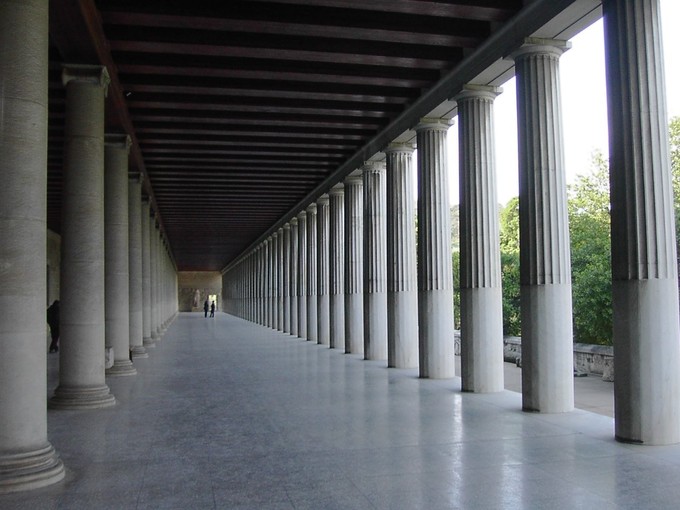
Temple of Apollo at Didyma
Other examples of grand and monumental architecture can be found in Ionia , modern day Turkey in Pergamon, and Didyma. The Temple of Apollo at Didyma was both a temple and an oracle site.
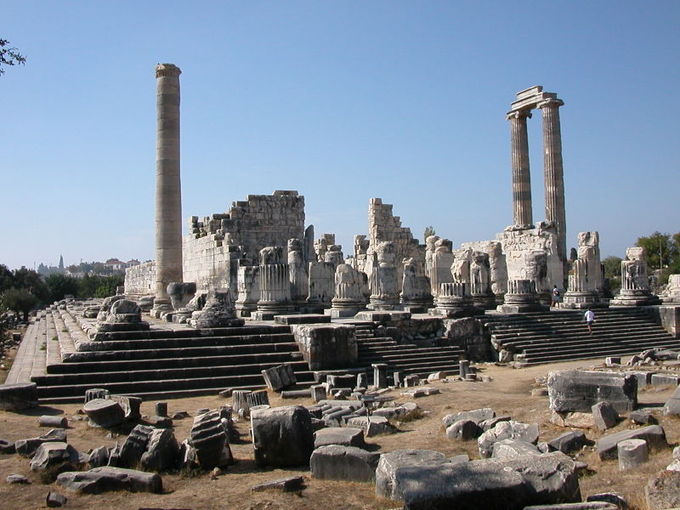
The temple was designed by the architects Paionios of Ephesus and Daphnis of Miletus. Its construction began in 313 BCE but was never completed, although work continued until the second century CE. This temple’s site is vast.
The interior court was 71 feet wide by 175 feet long and contained a small shrine. The court was also dipteral in form, edged with a double row of 108 columns, each 65 feet tall, that surrounded the temple. The structure creates a series of imposing spaces, from the exterior colonnade to the oracle rooms, and the interior courtyard inside of which the shrine to Apollo stood.
The building plan also played with theatricality and drama, forcing its visitors through a dark interior and then opening up into a bright and open courtyard that did not have a roof. The building is dramatically different from the perfected Classical plan of temples. Instead of focusing on symmetry and harmony, the building focuses on the experience of the viewer.
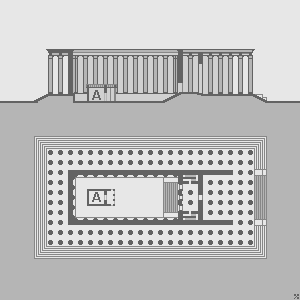
Corinthian Order
The Corinthian order is considered the third order of Classical architecture. The order’s columns are slender and fluted and sit atop a base . The capital consists of a double layer of acanthus leaves and stylized plant tendrils that curl up towards the abacus in the shape of a scroll or volute.
The decorative Corinthian order was not widely adopted in Greece, although it was popular in tholoi. It was, however, used substantially throughout the Roman period.
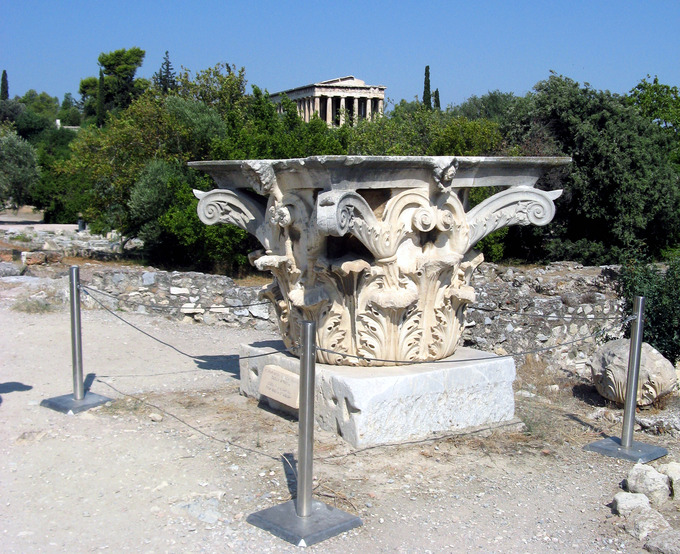
The ruined Temple of Olympian Zeus in Athens (also known as the Olympieion) contains one of the best-known examples of the Corinthian column in Hellenistic architecture. Originally designed in the Doric order in the sixth century BCE, the temple was redesigned in the second century BCE in the Corinthian order on a colossal platform measuring 134.5 feet by 353.5 feet.
It was to be flanked by a double colonnade of eight columns across the front and back and twenty-one on the flanks, surrounding the cella . The design was eventually changed to have three rows of eight columns across the front and back of the temple and a double row of twenty on the flanks, for a total of 104 columns. The columns stand 55.5 feet high and 6.5 feet in diameter. In 164 BCE, the death of Antiochus IV (who had presented himself as the earthly embodiment of Zeus) brought the project to a halt, and the temple would remain incomplete.
Pergamon
Pergamon rose as a power under the Attalids and provides examples of the drama and theatrics found in Hellenistic art and architecture.
Illustrate the dramatic and theatrical nature of the Pergamon, as seen in the Altar of Zeus, the Gigantomachy, and the Dying Gauls
Key Points
- Pergamon was the capital city of the Kingdom of Pergamon, which was ruled by the Attalids in the centuries following the death of Alexander the Great .
- The Acropolis of Pergamon is famous for its monumental architecture. Most of the buildings command a great view of the surrounding countryside and together create a dramatic public space .
- The Altar of Zeus at Pergamon was a monumental u-shaped Ionic building that stood on a high platform and was accessed by a wide set of stairs. Besides its dramatic architecture, the altar is known for its Gigantomachy frieze and sculptures of defeated Gauls .
- The Gigantomachy frieze represents the full blossoming of Hellenistic sculpture. The figures are dramatic, and the scenes are full of tension. They are carved in high relief with deep drilling that allows for a play of light and shadows that increases the naturalism of the figures.
- The statue group of the Dying Gauls depicts a defeated trumpeter and a Gallic chief killing himself and his wife. The figures, while enemies of Pergamon, are depicted with incredible pathos and heroics to demonstrate their worthiness as adversaries and empower the Attalid victors.
Key Terms
- chiastic: Referring to a figure that repeats concepts in reverse order, in the same or modified form.
- Gaul: An ancient person from the region that roughly corresponds to modern France and Belgium.
- torc: A large, rigid—or at least stiff—neck ring in metal, made either as a single piece or from strands twisted together.
The ancient city of Pergamon, now modern day Bergama in Turkey, was the capital of the Kingdom of Pergamon following the death of Alexander the Great and was ruled under the Attalid dynasty . The Acropolis of Pergamon is a prime example of Hellenistic architecture and the convergence of nature and architectural design to create dramatic and theatrical sites.
The acropolis was built into and on top a steep hill that commands great views of the surrounding countryside. Both the upper and lower portions of the acropolis were home to many important structures of urban life, including gymnasiums, agorae, baths, libraries, a theater, shrines, temples, and altars.
The theater at Pergamon could seat 10,000 people and was one of the steepest theaters in the ancient world. Like all Hellenic theaters, it was built into the hillside, which supported the structure and provided stadium seating that would have overlooked the ancient city and its surrounding countryside. The theater is one example of the creation and use of dramatic and theatrical architecture.
Altar of Zeus
Another element found at Pergamon is the great Altar of Zeus (now housed in Germany). The altar was commissioned in the first half of the second century BCE during the reign of King Eumenes II to commemorate his victory over the Gauls, who were migrating into Asia Minor.
The altar is a U-shaped Ionic building built on a high platform with central steps leading to the top. It faced east, was located near the theater of Pergamon, and commanded an outstanding view of the region. The altar is known for its grand design and for its frieze depicting the Gigantomachy—it wraps 370 feet around the base of the altar.
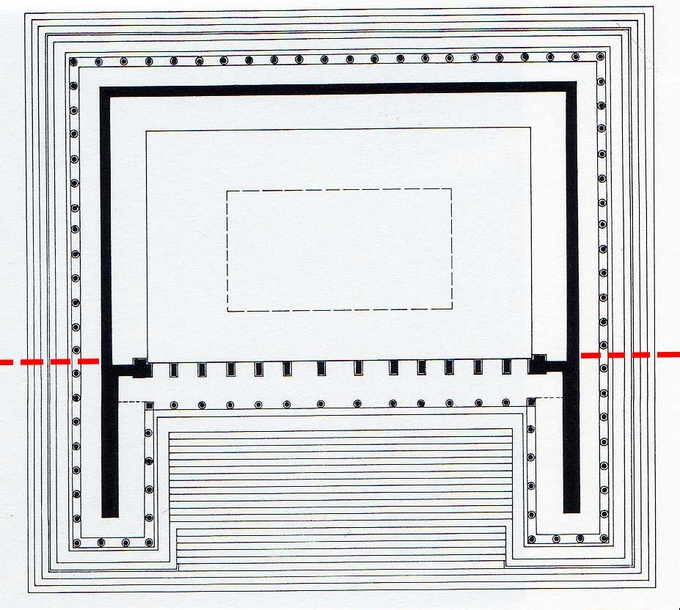

The Gigantomachy
The Gigantomachy depicts the Olympian gods fighting against their predecessors the Giants (Titans), the children of the goddess Gaia. The frieze is known for its incredibly high relief, in which the figures are barely restrained by the wall, and for its deep drilling of lines with details to create dramatic shadows.
The high relief and deep drilling of the figures also increases the liveliness and naturalism of the scene. The figures are rendered with high plasticity. The texture of their skin, drapery, and scales add another level of naturalism. Furthermore, as the frieze follows the stairs, the limbs of the figures begin to spill out of their frame and onto the stairs, physically breaking into the space of the viewer . The style and high drama of the scenes is often referred to as the Hellenistic Baroque for its exaggerated motion, emphasis on details, and the liveliness of the characters.
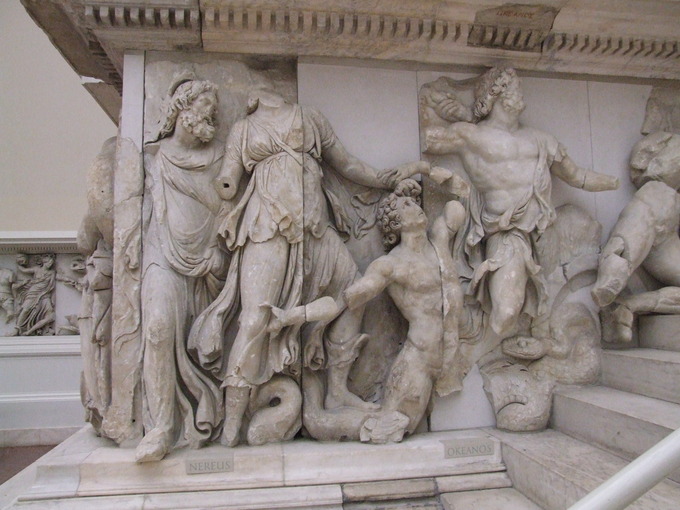
The most famous scene on the frieze depicts Athena fighting the giant Alkyoneus. She grabs his head and pulls it back while Gaia emerges from the ground to plead for her son’s life and a winged Nike reaches over to crown Athena.
Athena’s drapery swirls around her with deep folds and her whole body is nearly removed from the frieze. The figures are depicted with the heightened emotion commonly found on Hellenistic statues. Alkyoneus’s face strains in pain and Gaia’s eyes, which are all that remain of her face, are full of terror and sorrow at the death of her son.
The entire composition is depicted in a chiastic shape. Athena stretches out to grasps Alkoyneus’s head, the two figures pull at each other in opposite directions. Meanwhile, the figure of Nike moves diagonally towards Athena, showing their convergence in a moment of victory. The diagonal line created by Gaia mimics the shape of her son, connecting the two figures through line and pathos. The scene is filled with the tension and emotion that are key features in Hellenistic sculpture.
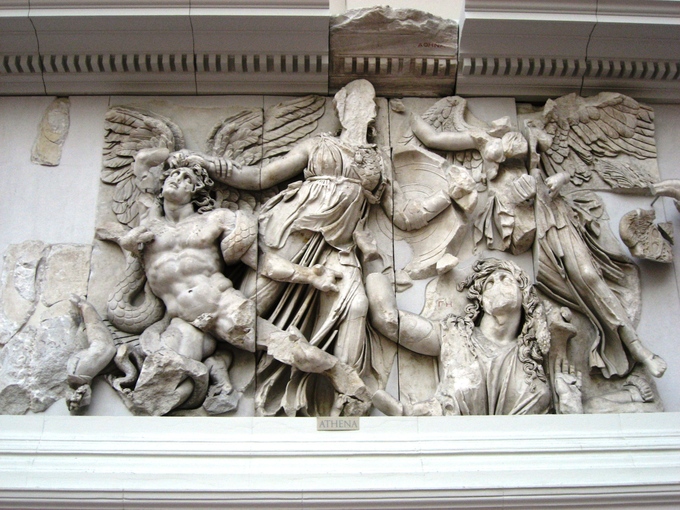
The Dying Gauls
A group of statues depicting dying Gauls, the defeated enemies of the Attalids, were situated inside the Altar of Zeus. The original set of statues is believed to have been cast in bronze by the court sculptor Epigonus in 230–220 BCE. Now only marble Roman copies of the figures remain.
Like the figures on the frieze and other Hellenistic sculptures, the figures are depicted with lifelike details and a high level of naturalism. They are also depicted in the common motif of barbarians. The men are nude and wear Celtic torcs . Their hair is shaggy and disheveled. The figures are positioned in dramatic compositions and are shown dying heroically, which turns them into worthy adversaries, increasing the perception of power of the Attalid dynasty. All three figures in the group are depicted in a Hellenistic manner. To fully appreciate the statues, it is best to walk around them. Their pain, nobility, and death are evident from all angles.
One Gaul is depicted lying down, supporting himself over his shield and a discarded trumpet. He furrows his brow as he looks downward at his bleeding chest wound as he prepares himself for death. His muscles are large and strong, signifying his strength as a warrior and implying the strength of the one who struck him down.

Two other figures complete the group. One figure depicts a Gallic chief committing suicide after he has killed his own wife. Also known as the Ludovisi Gaul, this sculpture group displays another heroic and noble deed of the foes, for typically women and children of the defeated would be murdered to avoid them from being captured and sold as slaves by the victors. The chief holds his fallen wife by the arm as he plunges his sword into his chest, where blood is already exiting the wound.
Sculpture in the Hellenistic Period
A key component of Hellenistic sculpture is the expression of a sculpture’s face and body to elicit an emotional response from the viewer.
Contrast the new Hellenistic style of sculpture from the previous Classical era, and discuss the significance of Roman patronage in the second century BCE
Key Points
- Hellenistic sculpture takes the naturalism of the body’s form and expression to level of hyper-realism where the expression of the sculpture’s face and body elicit an emotional response.
- Drama and pathos are new factors in Hellenistic sculpture. The style of the sculpting is no longer idealized. Rather, they are often exaggerated, and details are emphasized to add a new, heightened level of motion and pathos.
- New compositions and states of mind are explored in Hellenistic sculptures including old age, drunkenness, sleep, agony, and despair.
- Portraiture became popular in this period. The subjects are depicted with a sense of naturalism that displays their imperfections.
- Hellenistic sculpture was in especially high demand after the Greek peninsula fell to the Romans in 146 BCE. Notable sculptures produced for Roman patrons include
Laocoön and His Sons and the Farnese Bull.
Key Terms
- satyr: A male companion of Pan or Dionysus with the tail of a horse and a perpetual erection. Also known as a faun.
- patrician: An aristocrat or other elite member of society; it may also be used as an adjective.
- pathos: That quality or property of anything that touches the feelings or excites emotions and passions, especially that which awakens tender emotions, such as pity, sorrow, and the like; a contagious warmth of feeling, action, or expression; a pathetic quality.
Hellenistic sculpture continues the trend of increasing naturalism seen in the stylistic development of Greek art. During this time, the rules of Classical art were pushed and abandoned in favor of new themes, genres , drama, and pathos that were never explored by previous Greek artists.
Furthermore, the Greek artists added a new level of naturalism to their figures by adding an elasticity to their form and expressions, both facial and physical. These figures interact with their audience in a new theatrical manner by eliciting an emotional reaction from their view—this is known as pathos.
Nike of Samothrace
One of the most iconic statues of the period, the Nike of Samothrace, also known as the Winged Victory (c. 190 BCE), commemorates a naval victory. This Parian marble statue depicts Nike, now armless and headless, alighting onto the prow of the ship. The prow is visible beneath her feet, and the scene is filled with theatricality and naturalism as the statue reacts to her surroundings.
Nike’s feet, legs, and body thrust forward in contradiction to her drapery and wings that stream backwards. Her clothing whips around her from the wind and her wings lift upwards. This depiction provides the impression that she has just landed and that this is the precise moment that she is settling onto the ship’s prow.
In addition to the sculpting, the figure was most likely set within a fountain, creating a theatrical setting where both the imagery and the auditory effect of the fountain would create a striking image of action and triumph.

Venus de Milo
Also known as the Aphrodite of Melos (c. 130–100 BCE), this sculpture by Alexandros of Antioch, is another well-known icon of the Hellenistic period. Today the goddess’s arms are missing. It has been suggested that one arm clutched at her slipping drapery while the other arm held out an apple, an allusion to the Judgment of Paris and the abduction of Helen.
Originally, like all Greek sculptures, the statue would have been painted and adorned with metal jewelry, which is evident from the attachment holes. This image is in some ways similar to Praxitiles’ Late Classical sculpture Aphrodite of Knidos (fourth century BCE), but it is considered to be more erotic than its earlier counterpart.
For instance, while she is covered below the waist, Aphrodite makes little attempt to cover herself. She appears to be teasing and ignoring her viewer , instead of accosting him and making eye contact.
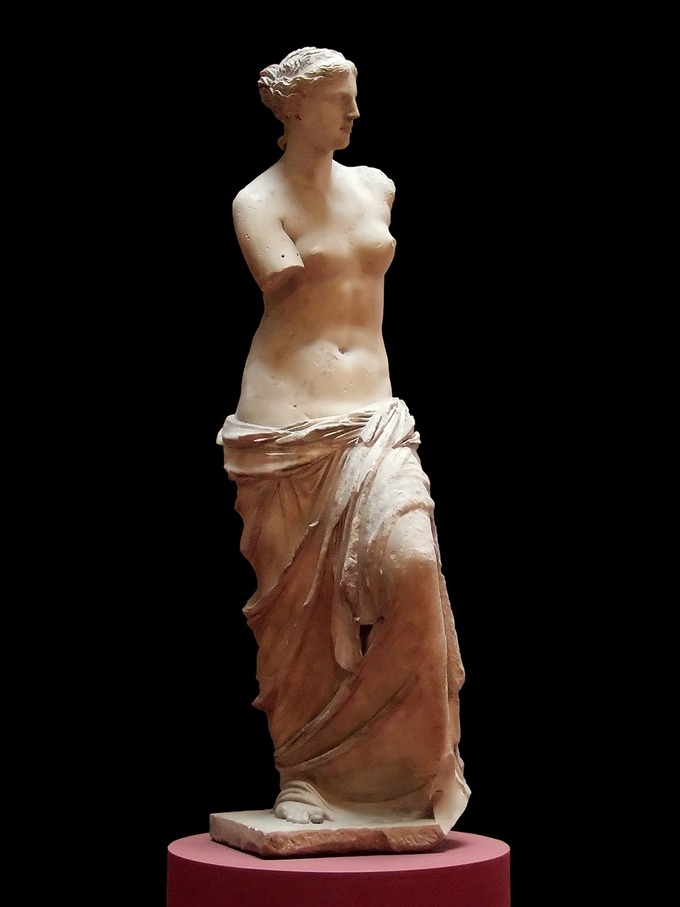
Altered States
While the Nike of Samothrace exudes a sense of drama and the Venus de Milo a new level of feminine sexuality, other Greek sculptors explored new states of being. Instead of reproducing images of the ideal Greek male or female, as was favored during the Classical period, sculptors began to depict images of the old, tired, sleeping, and drunk—none of which are ideal representations of a man or woman.
The Barberini Faun
The Barberini Faun, also known as the Sleeping Satyr (c. 220 BCE), depicts an effeminate figure, most likely a satyr, drunk and passed out on a rock. His body splays across the rock face without regard to modesty.
He appears to have fallen to sleep in the midst of a drunken revelry and he sleeps restlessly, his brow is knotted, face worried, and his limbs are tense and stiff. Unlike earlier depicts of nude men, but in a similar manner to the Venus de Milo, the Barberini Faun seems to exude sexuality.
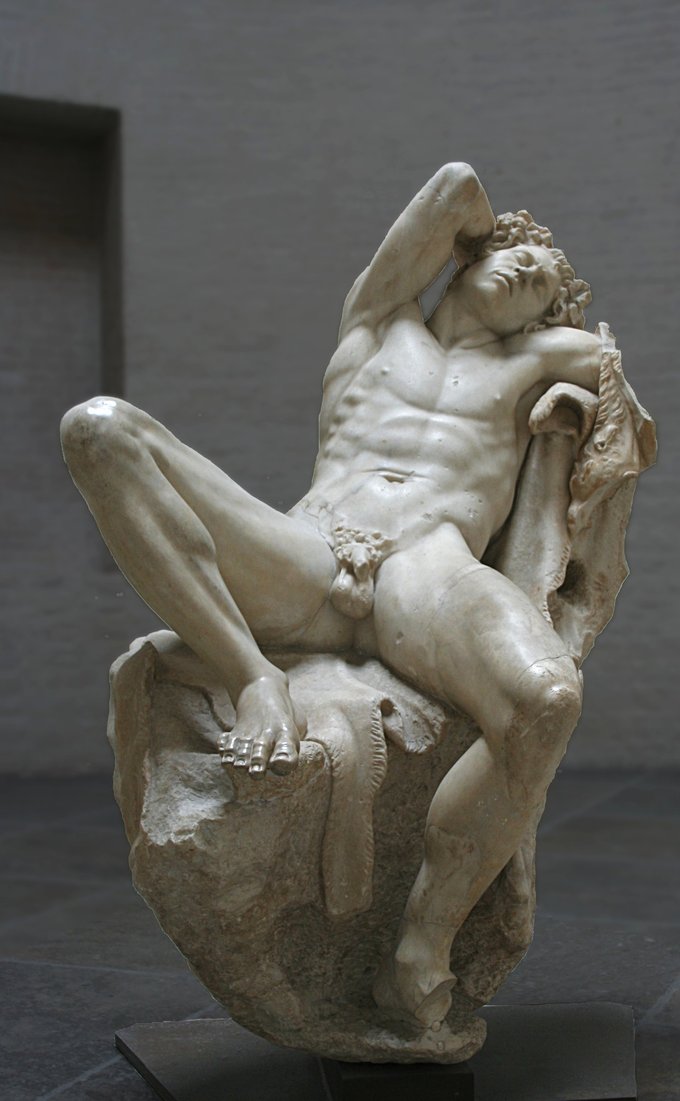
Drunken Old Woman
Images of drunkenness were also created of women, which can be seen in a statue attributed to the Hellenistic artist Myron of a drunken beggar woman. This woman sits on the floor with her arms and legs wrapped around a large jug and a hand gripping the jug’s neck.
Grape vines decorating the top of the jug make it clear that it holds wine. The woman’s face, instead of being expressionless, is turned upward and she appears to be calling out, possibly to passersby. Not only is she intoxicated, but she is old: deep wrinkles line her face, her eyes are sunken, and her bones stick out through her skin.
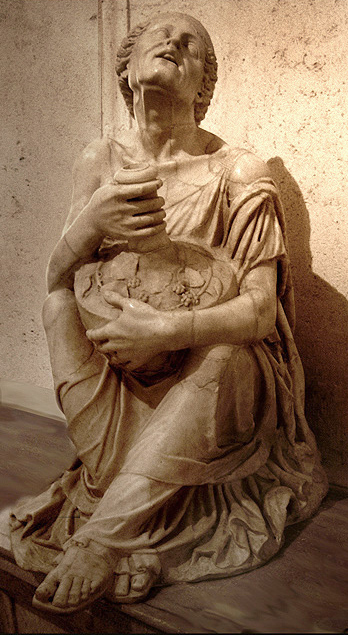
Seated Boxer
Another image of the old and weary is a bronze statue of a seated boxer. While the image of an athlete is a common theme in Greek art, this bronze presents a Hellenistic twist.
He is old and tired, much like the Late Classical image of a Weary Herakles. However, unlike Herakles, the boxer is depicted beaten and exhausted from his pursuit. His face is swollen, lip spilt, and ears cauliflowered. This is not an image of a heroic, young athlete but rather an old, defeated man many years past his prime.
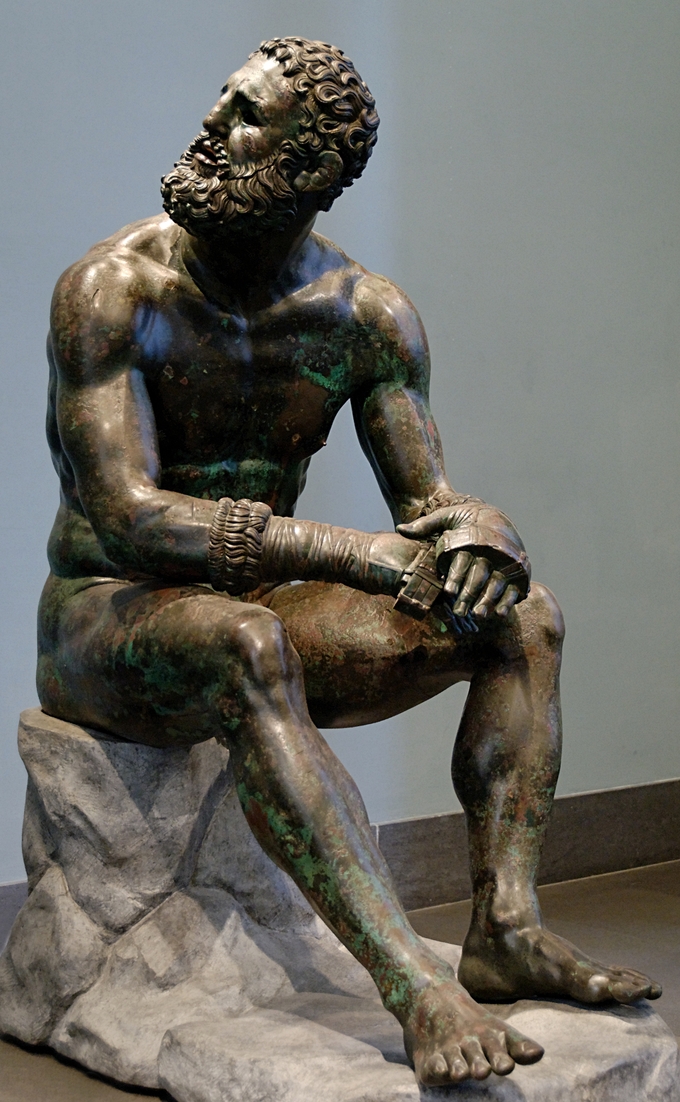
Portraiture
Individual portraits, instead of idealization, also became popular during the Hellenistic period. A portrait of Demosthenes by Polyeuktos (280 BCE) is not an idealization of the Athenian statesman and orator. Instead, the statue takes notes of Demosthenes’s characteristic features, including his overbite, furrowed brow, stooped shoulders, and old, loose skin.
Even portrait busts, often copied from Polyeuktos’ famed statue, depict the weariness and sorrow of a man despairing the conquest of Philip II and end of Athenian democracy.

Roman Patronage
The Greek peninsula fell to Roman power in 146 BCE. Greece was a key province of the Roman Empire, and the Roman’s interest in Greek culture helped to circulate Greek art around the empire, especially in Italy, during the Hellenistic period and into the Imperial period of Roman hegemony .
Greek sculptors were in high demand throughout the remaining territories of the Alexander’s empire and then throughout the Roman Empire. Famous Greek statues were copied and replicated for wealthy Roman patricians and Greek artists were commissioned for large-scale sculptures in the Hellenistic style.
Originally cast in bronze, many Greek sculptures that we have today survive only as marble Roman copies. Some of the most famous colossal marble groups were sculpted in the Hellenistic style for wealthy Roman patrons and for the imperial court. Despite their Roman audience, these were purposely created in the Greek style and continued to display the drama, tension, and pathos of Hellenistic art.
Laocoön and His Sons
Laocoön was a Trojan priest of Poseidon who warned the Trojans, “Beware of Greeks bearing gifts,” when the Greeks left a large wooden horse at the gates of Troy. Athena or Poseidon (depending on the story’s version), upset by his vain warning to his people, sent two sea serpents to torture and kill the priest and his two sons.
Laocoön and His Sons, a Hellenistic marble sculpture group (attributed by the Roman historian Pliny the Elder to the sculptors Agesander, Athenodoros, and Polydorus from the island of Rhodes) was created in the early first century CE to depict this scene from Virgil’s epic, The Aeneid.
Similar to other examples of Hellenistic sculpture, Laocoön and His Sons depicts a chiastic scene filled with drama, tension, and pathos. The figures writhe as they are caught in the coils of the serpents. The faces of the three men are filled with agony and toil, which is reflected in the tension and strain of their muscles. Laocoön stretches out in a long diagonal from his right arm to his left as he attempts to free himself.
His sons are also entangled by the serpents, and their faces react to their doom with confusion and despair. The carving and detail, the attention to the musculature of the body, and the deep drilling, seen in Laocoön’s hair and beard, are all characteristic elements of the Hellenistic style.
Farnese Bull
The Farnese Bull (c. 200–180 BCE), named for the patrician Roman family who owned the statue in the Italian Renaissance , is believed to have been created for the collection of Asinius Pollio, a Roman patrician. Pliny the Elder attributes the statue to the artists and brothers Apolllonius and Tauriscus of Trallles, Rhodes.
The colossal marble statue, carved from a single block of marble, depicts the myth of Dirce, the wife of the King of Thebes, who was tied to a bull by the sons of Antiope to punish her for mistreating their mother. The composition is large and dramatic, and demands the viewer to encircle it in order to view and appreciate the narrative and pathos from all angles. The various angles reveal different expressions, from the terror of Dirce, to the determination of Antiope’s sons, to the savagery of the bull.
- Curation and Revision. Provided by: Boundless.com. License: CC BY-SA: Attribution-ShareAlike
- Didyma. Provided by: Wikimedia. Located at: http://commons.wikimedia.org/wiki/File:Didyma.JPG. License: CC BY-SA: Attribution-ShareAlike
- Stoa in Athens. Provided by: Wikipedia. Located at: en.Wikipedia.org/wiki/File:Stoa_in_Athens.jpg. License: CC BY-SA: Attribution-ShareAlike
- 545px-Zevs-tempelet_med_Akropolis_bak.jpg. Provided by: Wikimedia Commons. Located at: https://commons.wikimedia.org/w/index.php?curid=6733532. License: Public Domain: No Known Copyright
- Corinthian Capital Agora. Provided by: Wikimedia. Located at: http://commons.wikimedia.org/wiki/File:Corinthian_Capital_Agora.jpg. License: CC BY-SA: Attribution-ShareAlike
- Hypaethraltempel. Provided by: Wikimedia. Located at: commons.wikimedia.org/wiki/File:Hypaethraltempel.png. License: CC BY-SA: Attribution-ShareAlike
- Abacus (Architecture). Provided by: Wikipedia. Located at: en.Wikipedia.org/wiki/Abacus_(architecture). License: CC BY-SA: Attribution-ShareAlike
- Ancient Greek Architecture. Provided by: Wikipedia. Located at: en.Wikipedia.org/wiki/Ancient_Greek_architecture. License: CC BY-SA: Attribution-ShareAlike
- Temple of Olympian Zeus, Athens. Provided by: Wikipedia. Located at: en.Wikipedia.org/wiki/Temple_of_Olympian_Zeus,_Athens. License: CC BY-SA: Attribution-ShareAlike
- Stoa. Provided by: Wiktionary. Located at: en.wiktionary.org/wiki/stoa. License: CC BY-SA: Attribution-ShareAlike
- Acanthus. Provided by: Wiktionary. Located at: en.wiktionary.org/wiki/acanthus. License: CC BY-SA: Attribution-ShareAlike
- Temple of Apollo (Didyma). Provided by: Wikipedia. Located at: en.Wikipedia.org/wiki/Temple_of_Apollo_(Didyma). License: CC BY-SA: Attribution-ShareAlike
- Corinthian Order. Provided by: Wikipedia. Located at: en.Wikipedia.org/wiki/Corinthian_order. License: CC BY-SA: Attribution-ShareAlike
- Classical Order. Provided by: Wikipedia. Located at: en.Wikipedia.org/wiki/Classical_order%23Corinthian_order. License: CC BY-SA: Attribution-ShareAlike
- Stoa. Provided by: Wikipedia. Located at: en.Wikipedia.org/wiki/Stoa. License: CC BY-SA: Attribution-ShareAlike
- Stoa of Attalos. Provided by: Wikipedia. Located at: en.Wikipedia.org/wiki/Stoa_of_Attalos. License: CC BY-SA: Attribution-ShareAlike
- Hellenistic art. Provided by: Wikipedia. Located at: en.Wikipedia.org/wiki/Hellenistic_art. License: CC BY-SA: Attribution-ShareAlike
- Orthogonal. Provided by: Wiktionary. Located at: en.wiktionary.org/wiki/orthogonal. License: CC BY-SA: Attribution-ShareAlike
- Volute. Provided by: Wiktionary. Located at: en.wiktionary.org/wiki/volute. License: CC BY-SA: Attribution-ShareAlike
- Colonnade. Provided by: Wiktionary. Located at: en.wiktionary.org/wiki/colonnade. License: CC BY-SA: Attribution-ShareAlike
- Dipteral. Provided by: Wiktionary. Located at: en.wiktionary.org/wiki/dipteral. License: CC BY-SA: Attribution-ShareAlike
- 640px-Modell_Pergamonmuseum.jpg. Provided by: Wikimedia Commons. Located at: commons.wikimedia.org/w/index.php?curid=301101. License: CC BY-SA: Attribution-ShareAlike
- Berlin - Pergamonmuseum - Altar 01. Provided by: Wikimedia. Located at: commons.wikimedia.org/wiki/File:Berlin_-_Pergamonmuseum_-_Altar_01.jpg. License: CC BY-SA: Attribution-ShareAlike
- 640px-Theatre_of_Pergamon.jpg. Provided by: Wikimedia Commons. Located at: commons.wikimedia.org/w/index.php?curid=42275209. License: CC BY-SA: Attribution-ShareAlike
- Pergamonmuseum - Antikensammlung - Pergamonaltar 13. Provided by: Wikipedia. Located at: en.Wikipedia.org/wiki/File:Pergamonmuseum_-_Antikensammlung_-_Pergamonaltar_13.jpg. License: CC BY-SA: Attribution-ShareAlike
- 316px-Ludovisi_Gaul_Altemps_Inv8608_n3.jpg. Provided by: Wikimedia Commons. Located at: commons.wikimedia.org/w/index.php?curid=1362961. License: Public Domain: No Known Copyright
- Dying gaul. Provided by: Wikimedia. Located at: commons.wikimedia.org/wiki/File:Dying_gaul.jpg. License: CC BY-SA: Attribution-ShareAlike
- Grundriss-Pergamonlatar rotate. Provided by: Wikipedia. Located at: en.Wikipedia.org/wiki/File:Grundriss-Pergamonlatar_rotate.jpg. License: CC BY-SA: Attribution-ShareAlike
- Nereus, Doris, Okeanos Pergamonaltar. Provided by: Wikimedia. Located at: commons.wikimedia.org/wiki/File:Nereus,_Doris,_Okeanos_Pergamonaltar_.JPG. License: CC BY-SA: Attribution-ShareAlike
- Ludovisi Gaul. Provided by: Wikipedia. Located at: en.Wikipedia.org/wiki/Ludovisi_Gaul. License: CC BY-SA: Attribution-ShareAlike
- Dying Gaul. Provided by: Wikipedia. Located at: en.Wikipedia.org/wiki/Dying_Gaul. License: CC BY-SA: Attribution-ShareAlike
- Pergamon Altar. Provided by: Wikipedia. Located at: en.Wikipedia.org/wiki/Pergamon_Altar. License: CC BY-SA: Attribution-ShareAlike
- Pergamon. Provided by: Wikipedia. Located at: en.Wikipedia.org/wiki/Pergamon. License: CC BY-SA: Attribution-ShareAlike
- Torc. Provided by: Wiktionary. Located at: en.wiktionary.org/wiki/torc. License: CC BY-SA: Attribution-ShareAlike
- Gaul. Provided by: Wiktionary. Located at: en.wiktionary.org/wiki/Gaul. License: CC BY-SA: Attribution-ShareAlike
- Aphrodite of Milos. Provided by: Wikimedia. Located at: commons.wikimedia.org/wiki/File:Aphrodite_of_Milos.jpg. License: CC BY-SA: Attribution-ShareAlike
- toro-farnese.jpeg. Provided by: Wikipedia. Located at: en.Wikipedia.org/wiki/File:Toro_farnese.JPG. License: CC BY-SA: Attribution-ShareAlike
- Laocooon-inv1059-1064-1067.jpeg. Provided by: Wikipedia. Located at: en.Wikipedia.org/wiki/File:Laocoon_Pio-Clementino_Inv1059-1064-1067.jpg. License: CC BY-SA: Attribution-ShareAlike
- Nike of Samothrake Louvre Ma2369. Provided by: Wikimedia. Located at: commons.wikimedia.org/wiki/File:Nike_of_Samothrake_Louvre_Ma2369.jpg. License: CC BY-SA: Attribution-ShareAlike
- Laocoon-detail.jpeg. Provided by: Wikimedia Commons. Located at: commons.wikimedia.org/wiki/File:Laocoon_Pio-Clementino_Inv1059-1064-1067_n6.jpg. License: CC BY-SA: Attribution-ShareAlike
- Thermae boxer Massimo Inv1055. Provided by: Wikimedia. Located at: commons.wikimedia.org/wiki/File:Thermae_boxer_Massimo_Inv1055.jpg. License: CC BY-SA: Attribution-ShareAlike
- Barberini Faun front Glyptothek Munich 218 n1. Provided by: Wikimedia. Located at: commons.wikimedia.org/wiki/File:Barberini_Faun_front_Glyptothek_Munich_218_n1.jpg. License: CC BY-SA: Attribution-ShareAlike
- Demosthenes Chiaramonti Inv1555. Provided by: Wikimedia. Located at: commons.wikimedia.org/wiki/File:Demosthenes_Chiaramonti_Inv1555.jpg. License: CC BY-SA: Attribution-ShareAlike
- Bebada2. Provided by: Wikimedia. Located at: commons.wikimedia.org/wiki/File:Bebada2.jpg. License: CC BY-SA: Attribution-ShareAlike
- Money and Fashion: The Commissions of Roman Patrons. Provided by: Boundless Learning. Located at: www.boundless.com/atoms/8030. License: CC BY-SA: Attribution-ShareAlike
- Ancient Greek Art. Provided by: Wikipedia. Located at: en.Wikipedia.org/wiki/Ancient_Greek_art%23Hellenistic. License: CC BY-SA: Attribution-ShareAlike
- Venus de Milo. Provided by: Wikipedia. Located at: en.Wikipedia.org/wiki/Venus_de_Milo. License: CC BY-SA: Attribution-ShareAlike
- Hellenistic Art. Provided by: Wikipedia. Located at: en.Wikipedia.org/wiki/Hellenistic_art%23Sculpture. License: CC BY-SA: Attribution-ShareAlike
- Barberini Faun. Provided by: Wikipedia. Located at: en.Wikipedia.org/wiki/Barberini_Faun. License: CC BY-SA: Attribution-ShareAlike
- Demosthenes. Provided by: Wikipedia. Located at: en.Wikipedia.org/wiki/Demosthenes. License: CC BY-SA: Attribution-ShareAlike
- Winged Victory of Samothrace. Provided by: Wikipedia. Located at: en.Wikipedia.org/wiki/Winged_Victory_of_Samothrace. License: CC BY-SA: Attribution-ShareAlike
- Pathos. Provided by: Wiktionary. Located at: en.wiktionary.org/wiki/pathos. License: CC BY-SA: Attribution-ShareAlike
- Satyr. Provided by: Wiktionary. Located at: en.wiktionary.org/wiki/satyr. License: CC BY-SA: Attribution-ShareAlike


